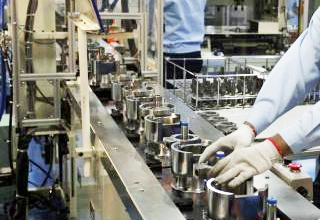Demonetisation Impact on GST and Liquidity Gridlock-led Business Growth Crisis
Updated: Nov 15, 2017

Demonetisation Impact on GST and Liquidity Gridlock-led Business Growth Crisis
Spill-over effects of demonetization and its impact on GST is having unintended consequence of acute liquidity crisis in trade and industry. There is a wide-spread delays/defaults in inter-firm credit based payment system. Businesses are experiencing a liquidity gridlock type situation where several payments each await the settlement of others. Due to this, a historic growth boosting reform like GST is facing unintended consequence of growth crisis. This happens as migration of unaccounted/informal transactions to formal transaction under GST needs to be matched by corresponding increase in availability of accounted money/credit. Broad money supply has not been reduced due to demonetization. Total value of the banned currencies have been almost entirely replaced by new currencies and extra bank deposits. This extra bank deposits is a mirror image of the decline in currency in circulation[CIC] from the pre-demonetisation level. The real problem facing the businesses is conversion of unaccounted/informal cash into accounted one to meet the payment requirements for transactions under GST. We can distinguish between unaccounted, informal and illegal transactions (corruption, crime, etc.). Unaccounted transactions are those legitimate transactions wherein income tax is not paid on the income earned from them. Informal transactions are the ones wherein income is earned and spent in cash but income earned is below IT exemption limit. Illegal transaction involves bribe, crime/drug money etc.
Impact of Undrawn Bank Deposits on Output/Sales
A substantial part of cash in banned currencies, which used to finance informal and unaccounted business dealings and consumption got deposited in banks during demonetization. About 3 crore new bank accounts have been opened during demonetisation period. These have increased to over 5 crore by now. Most of these are Jan Dhan accounts. These were opened under relaxed KYC norms. After withdrawal of money deposited with banks under demonetization, it is estimated that the undrawn extra deposits [ deposits over and above normal growth] under demonetization with banks were about Rs. 3.5-4 trillion as at end-March 2017. This extra deposits continues even now. These deposits are not drawn, inter alia, due to requirement of compliance of full KYC norms, restrictions on use of cash in business dealings and fear of monitoring/scrutiny of withdrawal and trail of its uses by IT Department. To the extent this idle deposits remains with banks, which were earlier used as medium of exchange in financing unaccounted/informal business activities and payment of trade debt, it would result in a corresponding reduction in production, employment and defaults/delayed repayments of debts. It also reduces consumption also as money remains with banks. A RBI study, on the basis of normal growth in CIC over the pre-demonetisation level, estimates that currency in circulation is about 19% less as at end-October 2017. Increased use and availability of bank credit/trade credit can mitigate the drastic decline in CIC. However, it is impractical to expect the volume of bank credit flows to informal sector to increase to the extent so as to replace the amount of excess deposits of the informal sector with banks during demonetisation. To the contrary bank credit has declined to industry and MSMEs during and post-demonetisation period. Given very low bank credit confidence and inefficient and poor intermediation of domestic savings record of banks; a negative shock by way of substantial reduction in CIC is having immediate and lasting effect of decline in output/prices. A large number of businesses across different sectors and particularly MSMEs/various trades are experiencing decline in output/sales. Heavily cash-based agriculture supply chain is suffering from drastic decline in prices. Agriculture produce prices are far below MSP rates. Again a substantial amount of household savings flowed to insurance schemes and mutual funds since the demonetisation. A part of this money was circulating in financing of business. Very low credit confidence both in banking and trade credit network, concern over counterparty payment of dues and uncertainty-led higher precautionary holding of liquidity and play-safe mode behaviour of businesses make the payment crisis monumental. These negate the expected growth gains from the GST.
Payment System Crisis
Payment system constitute a core element and plays a central role in transmission of liquidity shocks and contagion under market distress. Businesses are facing an acute liquidity crisis resulting in disruptions in payment system. There is widespread decline in average payment speed. Unsurprisingly, it is the employment and investment decisions of smaller businesses that are most sensitive to late payment. Transmission effects of this is extensive. Once a critical threshold of defaults/delayed is reached in the credit-based payment system, a systemic illiquidity cascade sets in. Counterparty payment risk spiralling into an epidemic, customers delaying payments to vendors, all players are reluctant to release payments. Default/delays on debt payment – actual or feared – always drives big financial/economic crisis. In fact, defaults/delays in inter-firm payments and bank credit repayments are the central feature of the present liquidity and growth crisis. There is a clear relationship between late payment/defaults and the rate of financial sickness/ insolvency/ bankruptcy/NPAs and loss of output. Liquidity shocks spread across wide-range of firms through direct and indirect financial interconnectedness. We are heading for a financial instability/contagion. Payment distress have self-reinforcing effects.
Advantages Chinese Import
A serious fall-out from decline in domestic manufacturing activities is benefitting already well entrenched system of under-invoiced import from China. Over the years, interactions between Chinese exporters and Indian importers and their agents evolved a trading framework so much that Chinese businesses very well adjust to our import requirements in terms of variety of products including duplicates, specifications, quality and price, under-invoicing/mis-invoicing of items in terms of products, size, weight, payment through Hawala, clearance of containers at ports and marketing logistics. Already our industrial economy had suffered major setback due to Chinese import. The current liquidity crisis will have further crippling effect on the output and employment.
The economy sliding into recession is a reality if solution to the cash-based business is not found. The fact of liquidity gridlock is not realised fully due to disconnect between policymakers and business ground realities. Excess bank liquidity does not help. Designing of GST and its operational modalities are mistaken as the cause of business growth crisis. No doubt there are some technical glitches which have some temporary impact but these can be set right. It is feared that noise of mistaken causes is leading to compromise over the fundamental structure of GST. Postponement of e-way bills, suspension of invoice-matching procedure and clamour for further simplification of procedures will give ample opportunities to business to game the GST system. It has already started. These will have major impact on revenue and effectiveness of GST as growth-oriented and efficient tax system.
Simple and Practical Solution
The real problem is conversion of unaccounted money into accounted one to finance GST transactions. Nobody talks about this as it is taken as black money. As explained above, it is not entirely so. The problem can be solved by allowing the conversion of unaccounted/informal cash/bank deposits with 3-10% penalty in case of firms registered under GST. Conversion can be restricted to deposits upto Rs. 2 crore. These can be fine tuned after discussions with trade and industry. This will enormously help businesses to increase their business under GST. Employment will increase. Tax revenue will surpass the estimates. It will be a continuous source of revenue in the years to come. It must be noted that in the past this money was used in financing economic activities. To bring unaccounted/informal businesses under GST, it would be practical to have a scheme of declaration of cash holding with the following conditions :
- This will be applicable only to businesses registered under GST
- All the cash holdings/bank deposits need to be deposited in a designated current account of a bank linked to business activities under GST
- The deposit can be used for business transactions only through e-payment/cheques except for a small percentage of cash for petty payments
- A graded penalty upfront on the total declared deposits/cash may be imposed, eg.; 3% for cash deposited upto Rs. 2 lakh, 5% on Rs. 2-10 lakh, 7% for amounts between Rs. 10-50 lakh and 10% between Rs. 50 lakh to Rs. 2 crore.
- The deposits limit upto Rs. 2 crore can take care of over 90% of informal/unaccounted business transactions. This may allow a business to have an annual turnover upto Rs. 8-10 crore assuming 4-5 working capital cycle in a year.
Why low penalty for conversion of cash into bank deposits ?
In a large number of cases, income generated through cash-based business activities in the informal sector falls under income tax exemption limit. These may not be unaccounted income. Most of the money owned by micro enterprises and retail businesses is their stock-in-trade built over the years. It provides livelihood to them. These are earned money and are not comparable with corruption/crime/drug money. Many times businesses are forced to go for informal business activities because of prevalent industry practices. Secondly, to stay competitive and survive one has to cut corners in tax matters if others in the industries are doing. It is mistaken view that all businesses are earning super profit by evading taxes. Due to intense competition, much of the gains from tax evasion is passed on as lower prices and a part of is paid to manage the tax evasion. Most of the businesses are left with survival level of earning. The ground realities is that most of the businesses are even not having a fair economic return on their total investment. Today traditional business communities prefer their children to go for jobs rather than do business. Under these circumstances, disclosure schemes with very steep penalties have not succeeded. Who will pay heavy penalties on livelihood capital ? Recapitalisation of banks will be successful only when this conversion is allowed. It is to be noted that over the last 50 years Govt./RBI have taken innumerable steps to increase timely and adequate flow to SMEs and small businesses. So far only 5% of SMEs are covered by bank credit. In case of trading firms, this percentage is even less. Banks are constrained by availability of data on actual operation level of firms. With GST this asymmetry of information can be overcome. Secondly, credit sales covered under GST gives legal record and backing to the dues of creditors. With GST receivable financing can be a big business for banks if timely realization of receivables is ensured by legal framework including strict time bound penalty for cheque bouncing. These will solve the problem of working capital. It will be win-win situation for both banks and businesses. We need to take an integrated view of all segments of financial system. Stand-alone actions like recapitalization will not work.
Without addressing the problem of unaccounted/informal cash and bank deposits, GST may not be able to achieve its objectives. To the contrary, it may accentuate growth slowdown and revenue loss. To have better and larger effect on growth and tax revenue, besides allowing conversion of unaccounted/informal money, it is imperative to have stringent checking of the under/mis-invoicing at port level, esp.; of Chinese import. This will go a long way in reducing cash-based dealings, hawala payments, illegal transactions, tax evasion and corruption. It will provide level playing field to Indian manufacturing.
About Author: Mr B L Chandak is Ex-DGM of SIDBI. He can be reached at blchandak@gmail.com








 Loading...
Loading...





COMMENTS
Be first to give your comments.